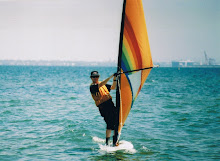So I've tried to be open minded and have consider these different designs. In the end I've decided to stick with the longboard design simply because it is a good all-round performer, and because aethestically it looks more attractive, certainly compared to the somewhat stubby looking formula board designs; and also because that is what I raced with much enjoyment in the '90s. Also, the hybrid board reminds me of my old Tiga 320 (a somewhat pancaked version), where the only reason for having a centreboard is to make the thing track in a straight line in light wind conditions.
I've also decided to stick with the traditional surf-board type of design rather than look to an approach which might yield improved performance in light wind displacement conditions. Such hybrid displacement-planning boards currently appears to force board shapes, which in the extreme, look like the Exocet Open 310 which doesn't sit well with my concept of a longboard shape. Also that shape must be a real killer downwind in a chop in 15 knts + .

Given this background, it now remains to finalise the overall board shape. To help with this, I've been plotting up normalised length to width profiles of various longboard shapes in order to get a better understanding of how the board shapes are evolving. For example, shown below are the board shapes of the Phantom 380 and the 'Equipe-III'.

A plot of the normalised length to width ratio for the two boards is given below and illustrates that the two boards have very similar shapes, with a maximum normalised width of 0.2 occurring at about half the distance from the tail to the nose. The plot also demonstrates that the Phantom 380 has a marginally wider tail and nose compared to the Equipe-III.
 I've generated these normalised aspect ratio plots for the IMCO, Pan-Am (thanks Richard for the images), the 380 and Equipe-III (as shown above), and for the Tiga 320 and have posted these below. These plots have helped me to make a decision regarding a good overall board shape to use with the longboard construction project.
I've generated these normalised aspect ratio plots for the IMCO, Pan-Am (thanks Richard for the images), the 380 and Equipe-III (as shown above), and for the Tiga 320 and have posted these below. These plots have helped me to make a decision regarding a good overall board shape to use with the longboard construction project.Following on from these comments let's compare the 380 and the IMCO. In so doing we are essentially comparing the old guard with the new kid on the block. It can be seen that the Phantom 380 is significantly wider- being up to 30% wider towards the tail and 20% wider towards the nose and 12% wider at the point of maximum width.


Now lets include the data on the Mistral Equipe-II Pan Am. This board is one of the last of the previous generation of longboards and probably represents the top of the evolutionary tree within that generation of boards. Looking at the aspect ratio plot below it can be seen that the shape of the Pan Am board lies between the Phantom 380 and the IMCO towards the nose and tail of the board, and matches the aspect ratio of the IMCO at the point of maximum width.


Finally, and for completeness, shown below is a plan view and the normalised aspect ratio plot of my old faithful Tiga. You can see that the Tiga is quite a bit smaller than the 380, although it has a larger width to length ratio at the point of maximum width when compared to the 380. I guess this is a consequence of having to maintain a reasonable board width simply from a point of view of board handling and board volume. Formula- and hybrid boards take this requirement to a much greater extreme and presumably would have maximum aspect ratios which are considerably greater than 0.2.

 Following an examination of the information shown above, plus a review of comments on the boards shapes available from the web, I've decided to base the longboard design on a slightly bulked up version of the Mistral Pan Am. I like the shape of this board, as do others who have or would like to obtain a Pan Am. Also there is that whole intangible nostalgia thing about racing against this board in the '90s. This class of board also recently won the world longboard championships.
Following an examination of the information shown above, plus a review of comments on the boards shapes available from the web, I've decided to base the longboard design on a slightly bulked up version of the Mistral Pan Am. I like the shape of this board, as do others who have or would like to obtain a Pan Am. Also there is that whole intangible nostalgia thing about racing against this board in the '90s. This class of board also recently won the world longboard championships.As it stands, the Pan Am has a length of 375 cm vs. the 380 cm of the Phantom. The Pan Am board width is 66 cm vs. 70 cm for the Phantom; and the Pan Am volume is 258 litres vs 295 litres of the Phantom. So the intent is to maintain the Pan Am shape, but to increase the length to 380 cm. The volume will be increased 1/ through the increase in length and, 2/ through adding boxier rails and greater 'rise' as per the Phantom 380. And of course the kick arse Pan Am rocker will be maintained.
See ya.
IMCO image:
(http://www.albaria.com/mistral/2005/onedesign_2005/onedesign2005.htm)
Exocet Open 310 image:
http://www.boardseekermag.com/special_features/olymic_board_2/olympic_board2.htm
